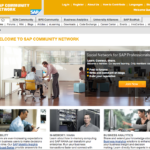In the hype that is social media marketing, it is often hard to distinguish between the braggadocio and the brilliant. Communities are launched with great fanfare only to slink away quietly into the burial ground of false promise. So to stumble across a vibrant community— one that predates Facebook and supports a B2B brand— is not just surprising, it is downright awe-inspiring.
 Thanks to the support of an enlightened board member in 2003, the SAP Community Network (SCN) was able to overcome internal naysayers, and gradually grow into a 2.5 million-member social business juggernaut. Now heading community operations, Chip Rodgers, who I interviewed in advance of his presentation at the B2B Corporate Social Media Summit, the SCN sets a high standard, revealing these 9 ways to know your community is truly awesome.
Thanks to the support of an enlightened board member in 2003, the SAP Community Network (SCN) was able to overcome internal naysayers, and gradually grow into a 2.5 million-member social business juggernaut. Now heading community operations, Chip Rodgers, who I interviewed in advance of his presentation at the B2B Corporate Social Media Summit, the SCN sets a high standard, revealing these 9 ways to know your community is truly awesome.
1. Adding members is no longer a key performance indicator
Because communities are still considered a luxury by some executives and a risk by many (rightly or wrongly) there is tremendous pressure in the early days to achieve scale. The SAP Community Network crossed this threshold in the last 24 months. Reports Rodgers, “Around the time we got close to 2 million, we stopped emphasizing the growth of the community.”
2. Community engagement is a daily activity
“If you build it, they will come,” is pure fiction when it comes to communities, which is why most wither away. Remarkably, the SCN gets about 1.5 million unique visitors per month and 3,000 to 4,000 posts a day. “Our activity numbers are really strong,” Rodgers explains. “I think that’s something we pride ourselves on as there are other communities that may have more members but feel like ghost towns; we have vibrancy.”
3. The community jumps in to defend the brand
It is inevitable that a brand will come under criticism for one thing or another once it opens up a community. Offers Rodgers, “We see this all the time where somebody says something negative or even a little wacky.” But rather than rushing out a brand response, “what ends up happening is a lot of community members [jump in saying] ‘This is way over the line,’ or ‘Nah that’s not really true.’’”
4. You can drive your own circulation
Building and maintaining a healthy community on the scale of the SCN is expensive so there is unavoidable pressure to demonstrate value to management. Rodgers notes, “One of our KPI’s is driving activity to webinars and that turns into real pipeline opportunity dollars traceable back to activity in the community.” In effect, the community acts like a media channel, supporting other marketing efforts and ultimately, top-line sales.
5. The community willingly embraces a direct sales channel
Purists worry that connecting a community with any kind of sales channel will dilute the value of the community. While there is a risk of being too “salesy,” an inevitable by-product of a healthy community are product discussions. Seeing these, SAP set up an online store called SAP EcoHub that started within the community and is now an increasing channel that drives real leads and revenue.
6. The community impacts product development
Customer-generated ideas have long been discussed as the holy grail of community activation, but getting there can be perilous. “The last thing we wanted to do was have a bunch of people contribute ideas and then have nobody listen or act on them,” Rodgers says. Working closely with the “proactive” product teams on selective topics, he has “gotten great feedback and contributions from the community that are already incorporated in the latest solutions.”
7. The marketing group wants in
Successful communities like the SCN are often started outside of marketing departments as a form of post-sale customer service. This orientation gives the community a head start since the emphasis is on creating content of genuine value and not pure product messaging. But with the heightened interest in having robust social media programs, it is not surprising that the SAP marketing department grabbed the reins of the SCN six months ago.
8. The community drives cultural change within marketing
Rodgers, who has run the SCN for five years, might have been apprehensive when marketing subsumed his group earlier this year, but you wouldn’t know it now. “Last year, our CMO said, ‘Guys we need to learn from [the SCN] and we need to have conversations and engage with our audience. We can’t just create another email blast with a bunch of creative and an offer.’”
9. The content developed on the community profoundly improves SEO
With a staff of 12 dedicated to developing formal content like white papers, articles and solutions briefs, Rodgers is able to keep up with his ravenous community, feeding it fresh content on a daily basis. And by optimizing this content for search, starting about 2 years ago, the SCN was able to more than double monthly site traffic. “I mean it was dramatic; it was unbelievable,” Rodgers observes with a sense of pride and awe.
Final note: It’s not often you hear about a huge B2B company operating with a B2C mentality for customer engagement. For my complete interview with Chip Rodgers, see my previous post here. You can visit the SAP Community Network at and hear Rodgers yourself at the upcoming B2B Corporate Social Media Summit in Philly on October 12th. This article first appeared on FastCompany.com.



